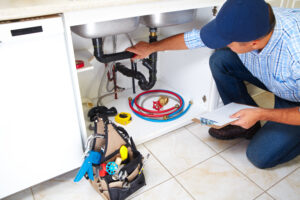When the Petersons woke up to what sounded like a babbling brook under their living room floor, they never expected to become experts in insurance policies and foundation repair.
“It was like discovering a secret underground river had moved in overnight,” jokes Robert Peterson, though his laughter fades when discussing the $12,000 repair bill that followed.
Their story opens a window into the complex world of slab leaks and the often-surprising reality of insurance coverage.
When Your Foundation Becomes a Water Park
The Underground Mystery

Will insurance help cover your leak repair?
Picture this: You’re sipping your morning coffee when you notice your feet are oddly warm on the tile floor, or worse, your water bill suddenly rivals your car payment. Welcome to the world of slab leaks, where your home’s concrete foundation harbors a secret plumbing drama that’s anything but entertaining.
Master plumber Tony Rodriguez, with 30 years of crawling under houses, puts it colorfully: “I tell my clients to think of their home’s foundation like a chocolate bar left in the sun – except instead of melted chocolate, you’re dealing with water finding every possible way to create chaos.”
Insurance Policies: The Fine Print Nobody Reads
The Coverage Carnival
“It’s like playing poker with a dealer who keeps changing the rules,” says insurance analyst Maria Chen. She’s reviewed thousands of slab leak claims over two decades, and her insights are eye-opening. “Most homeowners assume they’re fully covered until they’re standing in ankle-deep water, waving their policy at me like a white flag.”
The Plot Twist Nobody Expects
Take the case of retired teacher Eleanor Wright, who discovered her “comprehensive” coverage had more holes than a slice of Swiss cheese. “The adjuster actually told me they’d cover the water damage to my Persian rug but not the pipe causing the leak,” she recounts with a wry smile. “It’s like offering to buy someone new shoes while refusing to fix the nail they stepped on.”
The Money Pit Scenario
When Coverage Gets Creative
Insurance veteran James Murphy shares what he calls “The Tale of Two Leaks”: “I had two claims on the same street, same month. One homeowner got full coverage because a construction crew accidentally punctured their pipe. Their neighbor, whose 40-year-old copper pipe simply gave up the ghost, got nothing. Same damage, completely different outcomes.”
The Real Numbers Game
Consider these sobering statistics from a recent plumbers’ association study:
- Average slab leak repair cost: $4,000 to $15,000
- Percentage of homes over 20 years old at risk: 65%
- Average insurance payout when covered: 60% of total cost
- Number of homeowners who discover they’re underinsured: 8 out of 10
The Great Coverage Chase
Navigating the Maze
Former insurance adjuster turned consumer advocate Lisa Thompson doesn’t mince words: “The industry has mastered the art of the beautiful ‘maybe.’ Your policy might be 60 pages long, but the real answer to whether you’re covered often lies in three words buried on page 47.”
The Modern-Day Gold Rush
“It’s like prospecting,” explains contractor Mike Sullivan. “Except instead of panning for gold, we’re hunting for the exact clause in your policy that might save you thousands. I’ve seen people strike it rich with obscure policy riders they didn’t even know they had.”
Beyond the Obvious Damages
The Ripple Effect
The Hendersons learned this lesson the hard way. Their seemingly simple slab leak spawned a cascade of related issues:
- Foundation shifting that cracked their kitchen tiles
- Mold growth in walls that triggered allergies
- Electric bills soaring from constantly running dehumidifiers
- A property value drop when the issues showed up on inspection reports
The Hidden Time Bomb
“Water damage is like an iceberg,” warns structural engineer Dr. Patricia Lee. “What you see is maybe 20% of the actual problem. I’ve watched small leaks turn into $50,000 renovation projects because homeowners couldn’t get timely coverage approval.”
Smart Strategies for Modern Homeowners
The Prevention Game
Veteran home inspector Carlos Ramirez shares his golden rules:
- Monitor your water pressure regularly – it’s like taking your home’s blood pressure
- Install water sensors – think of them as smoke detectors for leaks
- Keep a monthly water bill diary – sudden increases are your first warning sign
- Schedule annual plumbing inspections – cheaper than emergency repairs
The Policy Power-Up
Investment in additional coverage might seem expensive until you need it. Sarah Chen, who narrowly avoided financial disaster thanks to her service line endorsement, offers this wisdom: “It’s like buying an umbrella before the storm. Sure, it’s an extra expense, but you’ll be grateful when the clouds break.”
The Future of Foundation Protection
Technology to the Rescue
Smart home technology is changing the game. New systems can detect microscopic leaks before they become catastrophic, and some insurance companies are offering discounts for homes equipped with these early warning systems.
The Insurance Evolution
Progressive companies are starting to offer what industry insiders call “comprehensive water coverage” – policies that specifically address the gray areas of water damage. As Rita Patel, a risk assessment specialist, notes, “The industry is finally catching up to the reality that modern homes need modern coverage.”
Your best defense against slab leak disasters is a combination of vigilance, documentation, and carefully selected coverage. Remember the Petersons? They turned their nightmare into a neighborhood wake-up call, organizing a community workshop on plumbing maintenance and insurance literacy.
Don’t wait for the sound of underground streams to review your coverage. As any seasoned homeowner will tell you, the best time to understand your insurance policy is long before you need to use it.





